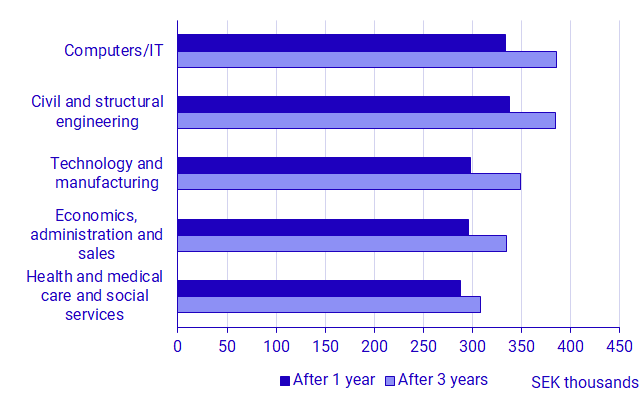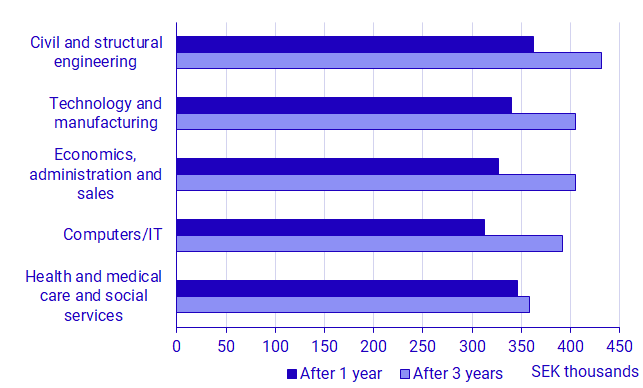Employment after graduation from higher vocational education, 2008-2018
Men with a qualification from higher vocational construction programmes earn more
Statistical news from Statistics Sweden 2020-12-15 9.30
After graduation from higher vocational education, income from work varies based on the field of education and between men and women. Three years after graduation in 2015, the highest incomes were among men with a degree in civil and structural engineering, and the lowest incomes were among women with a degree in health and medical care and social services.
These are the findings of a new report on employment, income, and position after graduation from higher vocational education. The report focuses on graduates from higher vocational education in 2015 and 2017, and their situation in the labour market one year and three years after graduation.
Three years after graduation, women’s income account for 82 percent of men’s income from work
Statistics on graduates from 2015 show that mean income from employment differed between men and women, and that this gap widened between 2016 and 2018. In 2016, women’s average income from employment was SEK 290 000 and for men it was SEK 330 000. In 2018, the corresponding figure for women was SEK 328 000 and for men it was SEK 397 000. In 2016, women’s average income corresponded to 88 percent of men’s income. By 2018, the corresponding proportion had fallen to 82 percent, which means that the gender income gap had increased.
After three years, highest income for women in computers/IT and highest income for men in civil and structural engineering
Women’s incomes were highest, both one year and three years after graduation, in the areas of computers/IT and in civil and structural engineering (around SEK 385 000 three years after graduation). The average income increased most in technology and manufacturing and in computers/IT, and increased the least in health and medical care.
In 2016, the average income was highest for men in civil and structural engineering, closely followed by health and medical care and social services. However, by 2018, incomes had increased much more in civil and structural engineering than in health and medical care. Therefore, in 2018, men with a qualification in civil and structural engineering had a clearly higher average income (around SEK 430 000). For men, the largest percentage increase between 2016 and 2018 was among those with a qualification in computers/IT and in economics, administration, and sales.
Graduates who work exclusively
Graduates who work exclusively
Definitions and explanations
Income from work is not the same as salary and wages. Earned income, that is, income from employment, is affected by the proportion of the year during which the person was in work, absence from work, full time or part time work, and factors such as overtime compensation. This is why income is a combination of how much the person worked and how high their salary was. Earned income refers to the sum of gross salary in cash and income from active business activities and work-related compensation, such as sickness benefit, parental allowance, and temporary parental allowance for care of children.
Average income refers to those who were in work in the current year, excluding those who both worked and studied.
Publication
Next publishing will be
2021
Feel free to use the facts from this statistical news but remember to state Source: Statistics Sweden.
